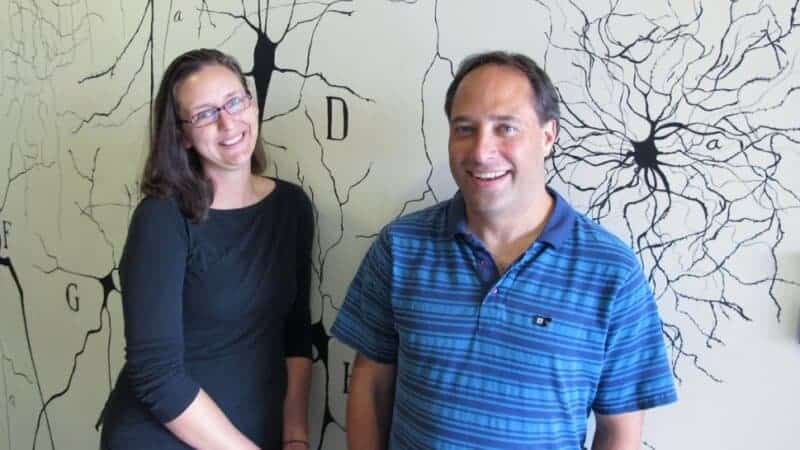By studying the way mice use their vision, scientists may be able to learn more about how human brains make decisions based on visual cues, say UO neuroscientists Cristopher Niell and Jennifer Hoy.
Using mice — usually prey for larger animals — as a model of visual system function has long been thought to be an ineffective way to study human vision. Mice are color blind, and their visual acuity is about 100 times worse than a human’s, suggesting that their vision is so poor that they could never provide insight into the visual functions of higher-order mammals such as humans.
In a paper published online ahead of print in the journal Current Biology, Niell and Hoy successfully demonstrated that mice actually use their eyesight to catch prey — in their experiments, a cricket.
“I had learned about owls producing prey capture behavior and how it’s related to development and plasticity,” said Hoy, a postdoctoral researcher in Niell’s lab. “I thought: ‘Wow, wouldn’t it be nice if we could access the brain circuitry the way we can for mice.’ Then I wondered if we could get mice to produce the same behavior.”
To pursue that idea, Hoy placed a cricket in a mouse’s habitat, a small box with plain white sides where the cricket was quickly caught and eaten. The next step was to determine which senses the mouse used to locate and approach its prey.
In a series of experiments, Hoy’s team showed that mice are dramatically more successful at following and catching crickets when they are able to see it; 96 percent of the crickets used in the study were successfully caught. When mice were fitted with earplugs, they captured crickets just as easily as when they could hear, but when mice were placed in the dark, it took them almost four times longer to locate the crickets.
They researchers next found that if vision and hearing were blocked at the same time, approach accuracy and capture rates fell much more dramatically than when just one sensory input was blocked. This suggests, they said, that auditory cues may aid prey capture in the absence of vision, but that vision serves as the dominant cue that enables rapid and accurate approaches from a distance.
As a final test, crickets were placed behind a barrier of clear plexiglass that eliminated all nonvisual cues. The mice made accurate approaches to their prey only in the light and made contact with the plexiglass just in front of the crickets. This approach allowed the researchers to determine how far away mice were on average when they began to accurately aim towards the prey.
The results provide convincing evidence that the mouse relies on its vision during the hunt, Niell and Hoy said.
“The mouse is easy to study because we can look and see how neurons work in ways that we can’t in primates and humans,” said Niell, a professor of biology and member of the UO’s Institute of Neuroscience. “We want to use the mouse as a vision model, and this research is very reassuring.”
In future experiments, Niell and Hoy want to examine the use of vision during prey capture to study how the brain encodes and transforms information it receives from the eyes. In addition to the visual cortex, they are interested in the more primitive part of the brain, the superior colliculus, which is responsible for instinctive reactions towards lights, movement and sounds.
There is much that is unknown about how the eyes, visual cortex and superior colliculus interact with each other during behavior, Niell said. “If I throw you a Frisbee and your reach out to catch it, how did you do that?”
The research eventually could have implications in some human conditions, Hoy said. The inability to suppress distracting sensory stimuli during tasks, for example, has been implicated in attention deficit hyperactivity disorder. Hoy says she wants to find out how a human brain is able to focus on a single object and how this ability develops as people mature.
“There’s this developmental phenomenon where if a child is focused on a task they are easily distracted by activity in their periphery, whereas with an adult that’s much less true,” Hoy said. “That process undergoes development as we mature, and that development is important for us to focus as an adult. I don’t think anyone fully understands how that process works, and that’s what I find interesting.”
Co-authors on the paper were UO psychology doctoral student Iryna Yavorska and Michael Wehr, a professor of psychology and member of the Institute of Neuroscience. The National Institutes of Health supported the research through grants to both Hoy and Niell.


